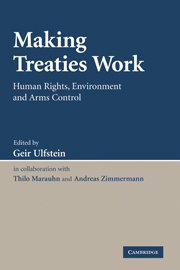Book contents
Introduction
Published online by Cambridge University Press: 05 September 2009
Summary
While States traditionally could resolve their problems by adopting legislation and other domestic measures, they are increasingly facing the fact that finding solutions to a given problem is beyond their national control. Current examples of such a development include international trade, security issues, the protection of the environment, cultural exchange and the protection of human rights.
This development has also changed the character of international law. In the 1960s, Wolfgang Friedmann had argued that international law had moved away from a ‘law of coexistence’ towards a ‘law of cooperation’. This means that States no longer are concerned only with the preservation of their sovereignty from international interference, but more and more engage in positive co-operation through treaties and international organizations. As of today, it might even be possible to refer to an emerging international ‘constitutionalism’. This concept refers to the increased significance of international institutions, which apply checks and balances comparable to those known from domestic law.
The Significane of treaties
Notwithstanding this development, treaties remain the most important instrument for regulating international affairs and the intercourse between States. Bruno Simma has accordingly called treaties the ‘workhorse’ of international law. They may be used for regulating any bilateral or multilateral relationship between States, be it the demarcation of a boundary, the establishment of a customs regime, the protection against climate change or the setting up of an international organization. But, as Simma notes, multilateral treaties are increasingly used to deal with common problems of the whole international community.
- Type
- Chapter
- Information
- Making Treaties WorkHuman Rights, Environment and Arms Control, pp. 3 - 12Publisher: Cambridge University PressPrint publication year: 2007
- 1
- Cited by



